Report on Public Transportation Enhancements in Pendleton
Introduction
The City of Pendleton is set to approve significant grant funding to enhance its public transportation system. This initiative places a strong emphasis on improving services for elderly and disabled residents, modernizing the transit fleet, and expanding infrastructure accessibility. These efforts align directly with several United Nations Sustainable Development Goals (SDGs), particularly those focused on reducing inequality, promoting well-being, and building sustainable communities.
Grant Funding and Strategic Partnerships for Sustainable Development
ODOT Elderly and Disabled Services Transportation Grant
A primary component of this initiative is a grant from the Oregon Department of Transportation (ODOT) aimed at bolstering services for vulnerable populations, a key target of SDG 10 (Reduced Inequalities). By ensuring access to mobility, the city also supports SDG 3 (Good Health and Well-being), as residents can more easily reach medical facilities and other essential services.
- Grant Amount: $302,000 from ODOT
- Required Local Match (10.27%): $34,565
- Total Project Funding: $336,565
- Grant Period: July 1, 2025, to June 30, 2027
- Services Supported: Daily van services and taxi ticket subsidies for elderly and disabled riders.
Additional Funding and Long-Term Commitment
The city’s commitment to creating a robust public transit system, in line with SDG 11 (Sustainable Cities and Communities), is further demonstrated by two additional ODOT grant agreements. This sustained funding, which Pendleton has received for over two decades, supports a variety of transit programs.
- Total Additional Funding: Nearly $490,000 through June 2027.
- Programs Supported: Elite Transit, Care-Ride, Dial-a-Ride, and other routes serving the general public, seniors, low-income residents, and people with disabilities.
This multi-faceted approach, involving collaboration between the City of Pendleton, ODOT, and Morrow County, exemplifies SDG 17 (Partnerships for the Goals), showcasing effective inter-agency cooperation to achieve community objectives.
Modernization of Transit Fleet and Infrastructure
Acquisition of Wheelchair-Accessible Bus
To advance the goal of a fully accessible transport system under SDG 11.2, the city plans to purchase a modern bus from Morrow County. This acquisition directly addresses the needs of persons with disabilities, a core tenet of SDG 10 (Reduced Inequalities).
- Vehicle: 2022 model bus
- Purchase Price: $84,000
- Capacity: 24 passengers (22 standard seats and 2 wheelchair-accessible stations)
- Purpose: Replaces a 2019 bus damaged beyond repair, ensuring service continuity.
Infrastructure Accessibility Improvements
In a related action, the city will approve a right-of-way agreement with ODOT. This agreement facilitates the replacement of intersection ramps to meet current accessibility standards, further contributing to the objectives of SDG 11 by creating safer and more inclusive public spaces at no direct cost to the city.
Impact on Community and Economic Development
Enhanced Service Routes and Community Access
The upgraded fleet and expanded services will improve connectivity across Pendleton, supporting local economic activity and social inclusion. This contributes to SDG 8 (Decent Work and Economic Growth) by providing reliable transportation to employment, education, and commercial centers.
- Continued Service: Routes will continue to serve key locations such as the high school, college, shopping areas, medical offices, and parks.
- New Service: A new stop near the Radisson Hotel will provide improved access to the airport, benefiting residents and visitors.
By ensuring residents can access healthcare, education, and employment, these transportation enhancements provide a foundation for improved quality of life and economic opportunity within the community.
Analysis of SDGs, Targets, and Indicators
1. Which SDGs are addressed or connected to the issues highlighted in the article?
- SDG 3: Good Health and Well-being: The article mentions that the public transit service connects to medical offices. By providing accessible transportation, especially for the elderly and disabled, the city helps ensure these residents can access essential healthcare services, which is crucial for their health and well-being.
- SDG 10: Reduced Inequalities: The primary focus of the grant and the transportation services is to support “elderly and disabled riders” and “low-income residents.” By improving access to transportation for these vulnerable groups, the city is actively working to reduce inequalities and promote their social inclusion.
- SDG 11: Sustainable Cities and Communities: The article is centered on improving public transportation within the city of Pendleton. It details efforts to create a more accessible, safe, and sustainable transport system by updating the fleet with modern, wheelchair-accessible buses and expanding services to key community locations like schools, shopping areas, and the airport.
2. What specific targets under those SDGs can be identified based on the article’s content?
- Target 11.2: “By 2030, provide access to safe, affordable, accessible and sustainable transport systems for all, improving road safety, notably by expanding public transport, with special attention to the needs of those in vulnerable situations, women, children, persons with disabilities and older persons.” This target is directly addressed as the article’s main theme is the expansion and modernization of public transit with a specific focus on services for the elderly and disabled, including the purchase of a wheelchair-accessible bus and the implementation of accessibility ramps.
- Target 10.2: “By 2030, empower and promote the social, economic and political inclusion of all, irrespective of age, sex, disability, race, ethnicity, origin, religion or economic or other status.” The article explicitly states that the grants support services for “seniors, low-income residents and people with disabilities.” Providing them with transportation enhances their ability to participate in community life, access jobs, education, and services, thereby promoting their inclusion.
- Target 3.8: “Achieve universal health coverage…and access to quality essential health-care services…” While not the main focus, this target is relevant because the article notes that the bus routes serve “medical offices.” Access to transportation is a critical enabler for accessing healthcare, and the services described help ensure that vulnerable populations are not prevented from receiving medical care due to a lack of transport.
3. Are there any indicators mentioned or implied in the article that can be used to measure progress towards the identified targets?
- Financial Investment: The article specifies the amount of funding allocated to these services. The “$302,000 grant” and another “combined total of nearly $490,000” for transportation programs serve as direct financial indicators of the city’s commitment to improving accessible transport.
- Availability of Accessible Vehicles: The “purchase of a modern, wheelchair-accessible bus” is a clear indicator of progress. The specific mention of “two wheelchair accessible stations” on the new bus provides a quantifiable measure of increased capacity for passengers with disabilities.
- Provision of Specialized Services: The implementation of “daily van services and taxi ticket subsidies for elderly and disabled riders” is an indicator of targeted programs designed to meet the needs of vulnerable populations. The existence and usage rates of services like “Care-Ride” and “Dial-a-Ride” can be tracked.
- Infrastructure Accessibility: The project to “move forward with replacing ramps at the intersection to meet accessibility standards” is a direct indicator of efforts to make the entire transportation system, not just the vehicles, accessible to people with disabilities.
- Service Coverage and Expansion: The addition of a “new stop near the Radisson Hotel, giving riders easier access to the airport” is an indicator of an expanding and more comprehensive public transit network that connects residents to key destinations.
SDGs, Targets, and Indicators Table
| SDGs | Targets | Indicators |
|---|---|---|
| SDG 11: Sustainable Cities and Communities | 11.2: Provide access to safe, affordable, accessible and sustainable transport systems for all, with special attention to the needs of those in vulnerable situations. |
|
| SDG 10: Reduced Inequalities | 10.2: Empower and promote the social, economic and political inclusion of all, irrespective of age, disability, or economic status. |
|
| SDG 3: Good Health and Well-being | 3.8: Achieve universal health coverage and access to quality essential health-care services. |
|
Source: eastoregonian.com







